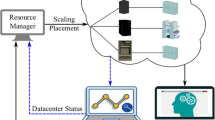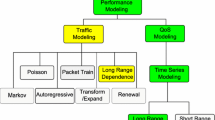Abstract
Accurate performance prediction of cloud workloads is essential for optimizing resource allocation, meeting service level agreements (SLAs), and ensuring efficient cloud service delivery. In this research paper, we conduct a comparative analysis of the ARIMA (Auto Regressive and Integrated Moving Average) time series model with other popular techniques for cloud workloads performance prediction. We evaluate the performance of ARIMA in comparison with other models, including machine learning algorithms and statistical methods, using real-world cloud workload performance data.
Bhupesh Kumar Dewangan and Tanupriya Choudhury both are mentioned as corresponding author(s).
Access this chapter
Tax calculation will be finalised at checkout
Purchases are for personal use only
Similar content being viewed by others
References
MacQueen J (1967) Some methods for classification and analysis of multivariate observations. In: Proceedings of the fifth Berkeley symposium on mathematical statistics and probability, vol 1, no 14, pp 281–297
Baghel SK (2012) Defense in depth for data storage in cloud computing. Int J Tech 2(2):58–61
Giri F, Deo RC (2020) Forecasting wind speed time series using hybrid ARIMA and K-means clustering algorithm. Appl Energy 275:115363
Agarwal A (2021) Workload aware autonomic resource management scheme using grey wolf optimization in cloud environment. IET Commun 15(14):1869–1882
Box GE, Jenkins GM, Reinsel GC (2015) Time series analysis: forecasting and control. Wiley & Sons
Venkatadri M (2019) Sla-based autonomic cloud resource management framework by antlion optimization algorithm. Int J Innov Technol Explor Eng (IJITEE) 8(4):119–123
Wei WW (2006) Time series analysis: univariate and multivariate methods. Pearson Education
Choudhury T (2021) An automated self-healing cloud computing framework for resource scheduling. Int J Grid High Perf Comput (IJGHPC) 13(1):47–64
Tsen C-M, Lee C-S (2006) A clustering-based method for time series data mining. Expert Syst Appl 31(2):274–284
Xu R, Wunsch D (2005) Survey of clustering algorithms. IEEE Trans Neural Networks 16(3):645–678
Hastie T, Tibshirani R, Friedman J (2009) The elements of statistical learning: data mining, inference, and prediction. Springer Science & Business Media
Shende P (2013) The sliding window method: an environment to evaluate user behavior trust in cloud technology. Int J Adv Res Comput Commun Eng 2(2):1158–1162
Pasricha A (2019) A self-optimization based virtual machine scheduling to workloads in cloud computing environment. Int J Eng Adv Technol (IJEAT) 8(4):91–96
Jain A, Shukla RN (2022) An ensemble of bacterial foraging, genetic, ant colony and particle swarm approach EB-GAP: a load balancing approach in cloud computing. Rec Adv Comput Sci Commun (Formerly: Recent Patents on Computer Science) 15(5):693–699
Shah JM, Kotecha K, Pandya S, Choksi DB, Joshi N (2017, May) Load balancing in cloud computing: Methodological survey on different types of algorithm. In: 2017 International conference on trends in electronics and informatics (ICEI). IEEE, pp 100–107
Ahmad F, Shahid M, Alam M, Ashraf Z, Sajid M, Kotecha K, Dhiman G (2022) Levelized multiple workflow allocation strategy under precedence constraints with task merging in IaaS cloud environment. IEEE Access 10:92809–92827
Author information
Authors and Affiliations
Corresponding authors
Editor information
Editors and Affiliations
Rights and permissions
Copyright information
© 2024 The Author(s), under exclusive license to Springer Nature Singapore Pte Ltd.
About this paper
Cite this paper
Mishra, V.K., Mishra, M., Dewangan, B.K., Amulya, P., Choudhury, T., Kotecha, K. (2024). Comparative Analysis of ARIMA Time Series Model and Other Techniques for Cloud Workloads Performance Prediction. In: Devi, B.R., Kumar, K., Raju, M., Raju, K.S., Sellathurai, M. (eds) Proceedings of Fifth International Conference on Computer and Communication Technologies. IC3T 2023. Lecture Notes in Networks and Systems, vol 898. Springer, Singapore. https://doi.org/10.1007/978-981-99-9707-7_32
Download citation
DOI: https://doi.org/10.1007/978-981-99-9707-7_32
Published:
Publisher Name: Springer, Singapore
Print ISBN: 978-981-99-9706-0
Online ISBN: 978-981-99-9707-7
eBook Packages: Intelligent Technologies and RoboticsIntelligent Technologies and Robotics (R0)




